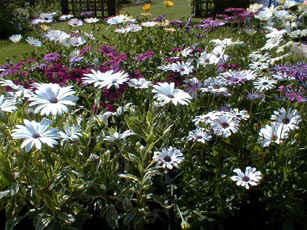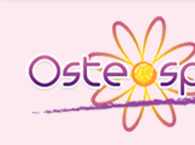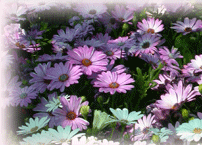Our love affair with Osteospermums began in 1994 when we noticed a lovely flowering daisy plant in a relative's front garden. It had a mass of flowers that were fully open in the warm summer sunshine. Not knowing much about plants at the time, we had no idea what it was! We later discovered it was a variety of Osteospermum called 'Lady Leitrim' or 'Paleface'. This particular narrow-leaved variety has a low ground hugging spreading habit, and is thought to be one of the hardiest varieties available. It has survived up to -13°C in our garden, even in heavy clay. It's white flowers that fade to pink have performed consistently well for us year after year, which probably explains why it has received an AGM (award of garden merit) from the RHS.
We were anxious to visit our local garden centre to see what plants they stocked. It didn't take long to find 'Buttermilk', a beautiful pale yellow coloured variety. Like most other Osteospermums, 'Buttermilk' is a half hardy perennial. Fortunately, it's very easy to propagate new plants by taking cuttings.
Osteospermums are relatively new to most gardeners, and were almost unheard of 25 years ago. They have risen in popularity in the last decade as they have become more commercially available. Osteospermums have now become very popular as summer bedding plants, either to put in the border or in pots. We have even used the prostrate varieties in hanging baskets to good effect. Osteospermums require full sun for the flowers to fully open, although while half-closed it is possible to appreciate the different colours on the underneath of the petals. Some old favourites such as 'Whirligig' and 'Pink Whirls' have spoon shaped petals. There are also stunning variegated leaf varieties available such as 'Giles Gilbey' and 'Silver Sparkler'.







